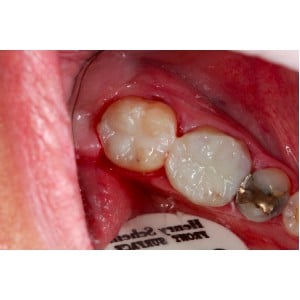Case Details
Does it hurt when you bite down?
How do we save a cracked tooth?
A tooth with a large silver filling. These fillings are safe but do expand and contract
over time and are malleable like a ball of tin foil! So repeated chewing can cause spreading forces. That with expansion and contraction of metal with temperatures can lead to a fracture. This fracture may make your tooth non-restorable so it might need to be extracted and replaced with an implant. We make attempts to save fractured teeth before they are totally broken by removing the old filling and bonding in a composite resin restoration to stop the crack.
It is also imperative to realize that cracked teeth may not be savable. If pain or sensitivity persist the tooth will require either a root canal or most likely extraction to eliminate this pain. In some instances if a root canal is done, the fracture (if it is self-limiting) can be eliminated and the tooth may still be salvageable.

Before

After
Description: Tooth with a large silver filling and visible crack showing.

Before

After
Description: Close up of the fracture showing how thin remaining tooth structure is.

Before

After
Description: Blue dye to trace the crack to ensure removal of all decay.

Before

After
Description: Sectional matrix called Palodent Plus being used to isolate the tooth from salvia and sequentially build the tooth up in layers to it’s proper form. Then the anatomy being replaced with a special burr to allow for some better esthetics. It is important to remember that unless a crown is done immediately the tooth may continue to fracture and be lost.

Before

After
Description: Enhance polishing discs being used to bring the tooth back to it’s original luster. Completed bonded restoration. This will be monitored to see if symptoms go away. If not the tooth will be lost.



